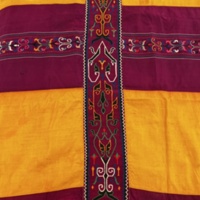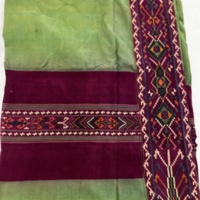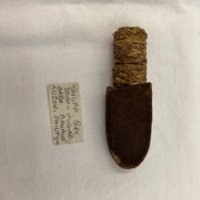Malong a Landap (Tubular Garment)
Text
Share this
Media
Images
Metadata
Identifier
RC2023_B1
Connection to Philippines
The Maranao (Meranao) are a Muslim ethnolinguistic group in Mindanao. It is most commonly worn by the royal (Sultan and its family) families or the elite people and is worn as a garment for men and women in daily and cermonial wear.
Materials
Silk called "Sutra"
A symbol of wealth and social class in the Maranao community and a symbol of perfection due to it being one of the finest woven products in the world. Each Landap is a symbol of royalty and value in Maranao society, in the past only Datu’s and Ea-e’s (Kings and Queens) their families and selected members of society could afford to wear them. It determines their position in society and depending on what colour they wear, it also showcases their title as well. For example, Green or “Gadong” is for juries and priests. Red or “Mariga” is worn by warriors and combatants. Magenta/Violet or “Rambayong” are reserved for Princesses, young ladies and Queens. And finally, Yellow is only worn by Sultans as it is a symbol of royalty. Any Maranao product with blend of colour yellow is considered to be royal or high class.
A symbol of wealth and social class in the Maranao community and a symbol of perfection due to it being one of the finest woven products in the world. Each Landap is a symbol of royalty and value in Maranao society, in the past only Datu’s and Ea-e’s (Kings and Queens) their families and selected members of society could afford to wear them. It determines their position in society and depending on what colour they wear, it also showcases their title as well. For example, Green or “Gadong” is for juries and priests. Red or “Mariga” is worn by warriors and combatants. Magenta/Violet or “Rambayong” are reserved for Princesses, young ladies and Queens. And finally, Yellow is only worn by Sultans as it is a symbol of royalty. Any Maranao product with blend of colour yellow is considered to be royal or high class.
Provenance
Maranao, Mindanao, Southern Philippines
Short description
A tubular silk skirt that is traditionally worn by the Sultan and other elite men and women of the Maranao ethnolinguistic group in Southern Philippines. Evidence shows that the Malong a Landap has been worn since the 1500s and is inspired by Indian textiles. It is one of the most highly valued types of Malong.
It is made out of a very thin silk called “Sutra”. The most commonly found colour scheme is the alternating colours of yellow and magenta, however solid colours of magenta, green, and white are known.
Tubes made of broad bands of silk that are joined together with tapestry bands called Langkit. It runs vertically and horizontally across which has been added for patterning. The wide vertical tapestry weave Langkit band is called a Lakban. The narrower band going down the middle of the Malong is called a Tobrian. The geometric designs of Langkit are similar to Okir, a Maranao woodcraving design. The “Kalwit”, a small bamboo stick is used to shape the patterns creating a mirror effect above and undear the cloth.
There are three parts in Malong a Landap. First being the Lakban which is the wide vertical tapestry weave sewed on the sides of the garment. There is also the Langkit which are tapestry bands that run vertically and horizontally across the Landap for patterning. Thirdly, the Tobrian, which is the narrower band that runs down the middle of the Malong.
It is made out of a very thin silk called “Sutra”. The most commonly found colour scheme is the alternating colours of yellow and magenta, however solid colours of magenta, green, and white are known.
Tubes made of broad bands of silk that are joined together with tapestry bands called Langkit. It runs vertically and horizontally across which has been added for patterning. The wide vertical tapestry weave Langkit band is called a Lakban. The narrower band going down the middle of the Malong is called a Tobrian. The geometric designs of Langkit are similar to Okir, a Maranao woodcraving design. The “Kalwit”, a small bamboo stick is used to shape the patterns creating a mirror effect above and undear the cloth.
There are three parts in Malong a Landap. First being the Lakban which is the wide vertical tapestry weave sewed on the sides of the garment. There is also the Langkit which are tapestry bands that run vertically and horizontally across the Landap for patterning. Thirdly, the Tobrian, which is the narrower band that runs down the middle of the Malong.
Collection
Cite this Page
“Malong a Landap (Tubular Garment),” Mapping Philippine Material Culture, accessed April 27, 2024, https://philippinestudies.uk/mapping/items/show/29332.
Sensitive Content
Mapping Philippine Material Culture collates digital material from institutions, and some of this material is inherently colonial and contains words, terms and phrases that are inaccurate, derogatory and harmful towards Filipino and Filipino diasporic communities. Catalogue transcriptions, book titles, exhibition titles and museum titles may contain harmful terms. We recognise the potential for the material to cause physical and mental distress as well as evoke strong emotions. Owing to the scale of the collection’s data, a process to implement sensitive-content warnings in the displayed data is still incomplete. The material within the catalogue does not represent Mapping Philippine Material Culture’s views. Mapping Philippine Material Culture maintains a strong anti-colonial, anti-racist position and affirms its support for centring the humanity of historically marginalised and disenfranchised communities.
Facebook Twitter



